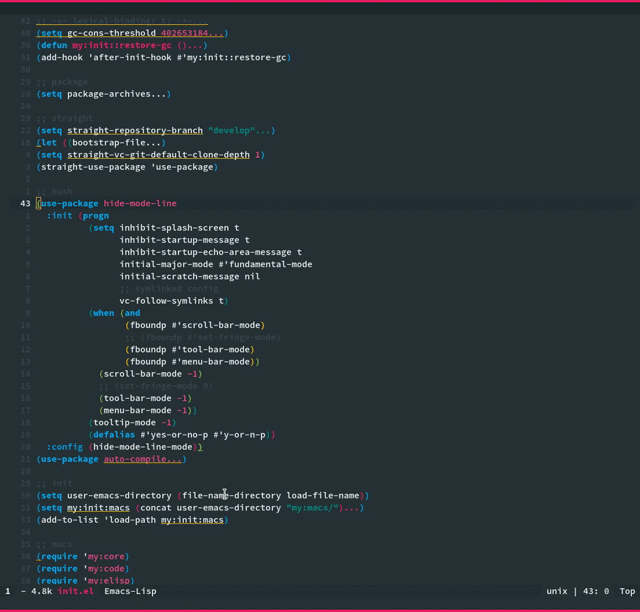An auto-magical, which-key based hydra banisher.
With almost no set-up code, hercules.el lets you call any group of
related command sequentially with no prefix keys, while showing a
handy popup to remember the bindings for those commands. hercules.el
can create both of these (the grouped commands, and the popup) from
any keymap. Here’s what that looks like:
(hercules-def
:toggle-funs #'macrostep-mode
:keymap 'macrostep-keymap)
(define-key <map-symbol> (kbd "<key>") #'macrostep-mode)Say that you want to move to the next babel source block in an org
file, and then realize you actually want to execute the one after
that. You would need to press C-c C-v n C-c C-v n C-c C-v e. Quite a
lengthy combination.
But if add this you your init file:
(hercules-def
;; read further to see why this works
:toggle-funs #'org-babel-mode
:keymap 'org-babel-map
:transient t)
;; tweak binding to taste
(define-key org-mode-map (kbd "C-c C-v") #'org-babel-mode)You would only need to press C-c C-v n n e, and while you’re doing
so, you would get a pop-up listing all the keybindings that follow
C-c C-v in case you forget. Because of the :transient keyword,
once you press a key that’s not in the pop-up, the hercules.el
window will disappear and you will be dropped back into your regular
bindings.
If only there was a way to make a hydra without having to list all
the bindings explicitly… Kind of like which-key…
hercules.el implements the functionality of
hydra by leveraging
which-key auto-magic.
Unlike hydra, hercules.el entry and exit points are associated
with functions, not keys. Keys, on the other hand, are defined by
traditional keymaps, which you can use as-is, or tweak to your liking
using your tool of choice. hercules.el doesn’t force this choice on
you. That said, I highly recommend
general.el.
Ultimately, hercules.el saves you time by relying on work that has
already been done for you — usually, but not necessarily, as part of
a time-tested minor-mode. The resulting interfaces tend to be more
comprehensive than home-grown hydras, thus aiding you in
discovering new functionality.
Allow me to illustrate my point using an example from hydras README:
(defhydra hydra-buffer-menu (:color pink
:hint nil)
"
^Mark^ ^Unmark^ ^Actions^ ^Search
^^^^^^^^-----------------------------------------------------------------
_m_: mark _u_: unmark _x_: execute _R_: re-isearch
_s_: save _U_: unmark up _b_: bury _I_: isearch
_d_: delete ^ ^ _g_: refresh _O_: multi-occur
_D_: delete up ^ ^ _T_: files only: % -28`Buffer-menu-files-only
_~_: modified
"
("m" Buffer-menu-mark)
("u" Buffer-menu-unmark)
("U" Buffer-menu-backup-unmark)
("d" Buffer-menu-delete)
("D" Buffer-menu-delete-backwards)
("s" Buffer-menu-save)
("~" Buffer-menu-not-modified)
("x" Buffer-menu-execute)
("b" Buffer-menu-bury)
("g" revert-buffer)
("T" Buffer-menu-toggle-files-only)
("O" Buffer-menu-multi-occur :color blue)
("I" Buffer-menu-isearch-buffers :color blue)
("R" Buffer-menu-isearch-buffers-regexp :color blue)
("c" nil "cancel")
("v" Buffer-menu-select "select" :color blue)
("o" Buffer-menu-other-window "other-window" :color blue)
("q" quit-window "quit" :color blue))
(define-key Buffer-menu-mode-map "." 'hydra-buffer-menu/body)NOTE: This is the equivalent of hydra’s buffer setup applied to window manipulation, since I don’t use buffer-menu. Implementing it yourself should be trivial.
(hercules-def
:show-funs #'windresize
:hide-funs '(windresize-exit windresize-cancel-and-quit)
:keymap 'windresize-map)
(define-key <map-symbol> (kbd "<key>") #'windresize)Last, and definitely least, hercules.el provides a more consistent
interface for all your keybinding popup needs (the same which-key UI
throughout your config).
As mentioned, I initially wrote hercules.el to avoid reinventing the
wheel by creating elaborate hydras for minor-modes that already worked
like they had them, merely lacking the handy popup. These include:
macrostep-modeedebug-modedebugger-modewindresize- many more
But hercules.el can use any keymap you have lying around, even if
there’s no mode associated with it. Just make one up. For example, you
can steal org-babel-map and whip up what used to be a massive
hydra in seconds:
(hercules-def
:toggle-funs #'org-babel-mode
:keymap 'org-babel-map
:transient t)
(define-key <map-symbol> (kbd "<key>") #'org-babel-mode)Pressing any key outside the map will leave the pseudo-mode and hide
the hercules.el pop-up if TRANSIENT is t. But you can also use
the HIDE-FUNS and TOGGLE-FUNS arguments to do the same while
executing one last Hail Mary command. Combining them is not a problem
either.
Too crowded for you?
(hercules-def
:toggle-funs #'org-babel-mode
:keymap 'org-babel-map
:whitelist-keys '("n" "p" "t")
:transient t)
(define-key <map-symbol> (kbd "<key>") #'org-babel-mode)You can also use BLACKLIST-KEYS, BLACKLIST-FUNS, and WHITELIST-FUNS. to this end.
What about defining hercules.el pop-ups from scratch? Easy. Keep in
mind this would usually take 4 defhydra calls that would need to be
explicitly connected.
(general-def
:prefix-map 'my-random-map
"f" #'foo
"b" #'bar
"z" #'baz
"m" '(:ignore t :wk "mmap")
"mf" #'mfoo
"mb" #'mbar
"mz" #'mbaz
"n" '(:ignore t :wk "nmap")
"nf" #'nfoo
"nb" #'nbar
"nz" #'nbaz
"o" '(:ignore t :wk "omap")
"of" #'ofoo
"ob" #'obar
"oz" #'obaz)
(hercules-def
:toggle-funs #'my-random-mode
:keymap 'my-random-map
:transient t)
(define-key <map-symbol> (kbd "<key>") #'my-random-mode)Want to still see the entire keymap on prefix-key press? Done. Just call
hercules-def like so instead:
(hercules-def
:toggle-funs #'my-random-mode
:keymap 'my-random-map
:transient t
;; flatten nested keymaps
:flatten t)The only userland function you should concern yourself with is
hercules-def. As such, you should get to know it well.
TOGGLE-FUNS, SHOW-FUNS, and HIDE-FUNS define entry and exit
points for hercules.el to show KEYMAP. Both single functions and
lists work. As all other arguments to hercules-def, these must be
quoted.
KEYMAP specifies the keymap for hercules.el to make a pop-up out
of. If KEYMAP is nil, it is assumed that one of SHOW-FUNS or
TOGGLE-FUNS results in a which-key--show-popup call. This may be
useful for functions such as which-key-show-top-level. I use it to
remind myself of some obscure Evil commands from time to time.
FLATTEN displays all maps and sub-maps together, without redrawing
on prefix-key presses. This allows for multi-key combinations in a
single hercules.el buffer.
BLACKLIST-KEYS and WHITELIST-KEYS specify which (kbd
interpretable) keys should removed from/allowed to remain on
KEYMAP. Handy if you want to unbind things in bulk and don’t want to
get your hands dirty with keymaps. Both single characters and lists
work. Blacklists take precedence over whitelists.
BLACKLIST-FUNS and WHITELIST-FUNS are analogous to BLACKLIST-KEYS and WHITELIST-KEYS except that they operate on function symbols. These might be useful if a keymap specifies multiple bindings for a commands and pruning it is more efficient this way. Blacklists again take precedence over whitelists.
PACKAGE must be passed along with BLACKLIST-KEYS, WHITELIST-KEYS, BLACKLIST-FUNS, or WHITELIST-FUNS if KEYMAP belongs to a lazy loaded package. Its contents should be the package name as a quoted symbol.
Setting TRANSIENT to t allows you to get away with not setting
HIDE-FUNS or TOGGLE-FUNS by dismissing hercules.el whenever you
press a key not on KEYMAP.

